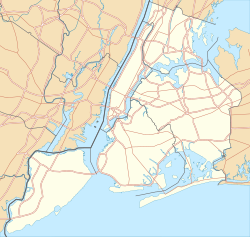Office of the Register | |
 The former Queens Office of the Register, now the Jamaica Center for Arts and Learning | |
| Location | 161-04 Jamaica Avenue, Jamaica, New York 11432, United States |
|---|---|
| Coordinates | 40°42′14″N73°47′53″W / 40.70375°N 73.79816°W |
| Area | less than one acre |
| Built | 1904 |
| Architectural style | Late 19th And 20th Century Revivals, Neo-Italian Renaissance |
| NRHP reference No. | 80002754 [1] |
| NYCL No. | 0875 |
| Significant dates | |
| Added to NRHP | January 3, 1980 |
| Designated NYCL | November 12, 1974 |
The Jamaica Center for Arts & Learning in Jamaica, Queens, New York is a performing and visual arts center that was founded in 1972 in an effort to revitalize the surrounding business district. As of 2012, it serves more than 28,000 people annually via a 1,650 square foot gallery, a 99-seat proscenium theater, and art & music studios. The building that houses the center is the former Queens Register of Titles and Deeds Building, a New York City landmark that is also listed on the National Register of Historic Places. [2] Outside the building is the sidewalk clock on Jamaica Avenue, one of only two remaining cast-iron sidewalk clocks in New York City, [3] as well as a late-Victorian era headquarters of the Jamaica Savings Bank next door.




